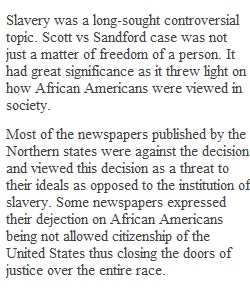


Q This discussion addresses the following outcomes: • Interpret the reactions to the Dred Scott v. Sanford court case from several historical perspectives and consider the case’s role in the sectional crisis over slavery and the 1860 election. (CO#4, CO#5, CO#6/Gen. Ed. Outcome 4.2) The 1857 Supreme Court decision Scott v. Sandford was significant in the decade preceding the Civil War. Those who instituted the case were concerned with the fate of Dred Scott and his wife, and also in exploring slavery’s legal limits. Scott v. Sandford opened the proverbial Pandora’s Box by revisiting and reconsidering the legal and political compromises that had occurred over the years. Its controversial outcome might have given the South more legal ground to stand on but also stimulated Northern opposition to the South and stoked fears about the “slave power.” Consider, for example, the political cartoon above published by an unknown artist in Harper’s Weekly in 1860. The cartoon showcases the effect Americans believed the Dred Scott decision would have on the consideration of slavery in the 1860 presidential election. Harper’s Weekly (Links to an external site.) describes the scene as: The burning question of the future of slavery in the United States was addressed by several of the contenders during the 1860 race. Here the four presidential candidates dance with members of their supposed respective constituencies. The music is fiddled by Dred Scott, the former slave whose suit precipitated the court's decision. Scott sits on a chair at center. In the upper left is Southern Democrat John C. Breckinridge. He is paired with Democratic incumbent and ally James Buchanan, depicted as a goat or (as he was nicknamed) "Buck." At the upper right Republican Abraham Lincoln prances arm-in-arm with a black woman, a pejorative reference to his party's alignment with the abolitionists. At lower right Constitutional Union party candidate John Bell dances with an Indian brave. This pairing is puzzling but may allude to Bell's brief flirtation with Native American interests. (For one instance of the use of the Indian as a nativist symbol see "Know Nothing Soap," no. 1854-3.) At lower left Stephen A. Douglas dances with a ragged Irishman. Associated with Douglas in several cartoons (see "The Undecided Political Prize Fight," no. 1860-22) the Irishman, here wearing a cross, may be intended as a reference to Douglas's backing among Irish immigrants and allegations of the candidate's Catholicism. In preparation for this discussion, read a few of the editorials from the Dred Scott portion of the Secession Era Editorial Project (Links to an external site.) compiled by the Furman University Department of History. You can sort either by date of publication or by newspaper and party (Republican, Democrat and American or “Know Nothing”). Be aware that newspapers back then were openly partisan, so the notion of detachment or objectivity does not apply. Read through at least the editorials, balancing Northern and Southern newspapers. Please then read an excerpt of the Court’s decision at Key Excerpts from the Majority Opinion, Dred Scott (Links to an external site.) which should provide you with a good summary Chief Justice Roger Taney’s reasoning. In addition, be sure to read the Module Notes and Chapter 13: “The Sectional Crisis (Links to an external site.)” in The American Yawp and view Irrepressible Conflicts (Links to an external site.). Using the primary and secondary source materials above as evidence, consider the following in a post of at least 250 words: • Based on the articles you chose, how did Northern and Southern newspapers argue that the Scott vs. Sandford decision would affect the sectional debate? What previous political compromises regarding slavery in the western territories would have to be changed or at the least revisited in the wake of the case? • From the perspective of 1857, summarize the predictions of what the Scott v. Sandford decision would mean for the US. Then, over the course of the week, respond to the posts of at least two of your classmates. Your initial post is due by Thursday at 11:59PM. Your responses are due by Sunday at 11:59PM. Consult the Discussion Posting Guide for information about writing your discussion posts. It is recommended that you write your post in a document first. Check your work and correct any spelling or grammatical errors. When you are ready to make your initial post, click on "Reply." Then copy/paste the text into the message field, and click "Post Reply." This is a “post first” discussion forum. You must submit your initial post before you can view other students’ posts.
View Related Questions